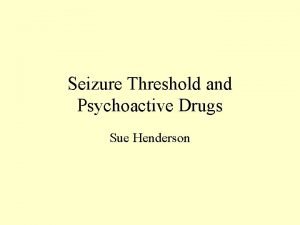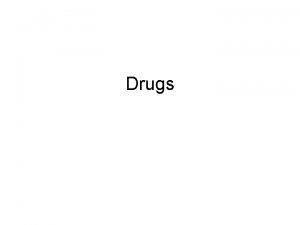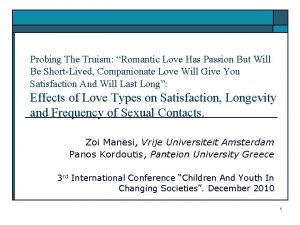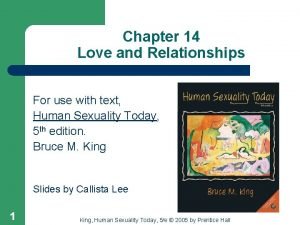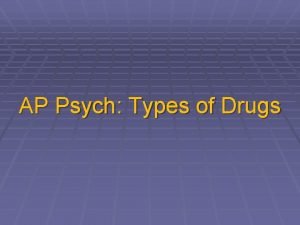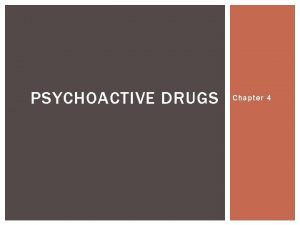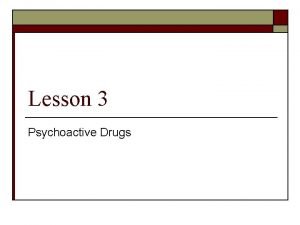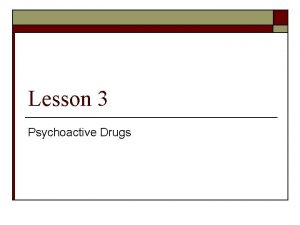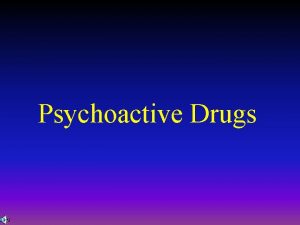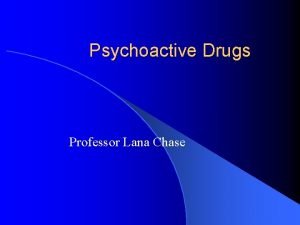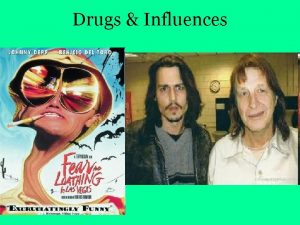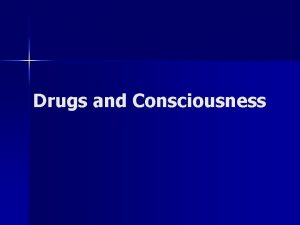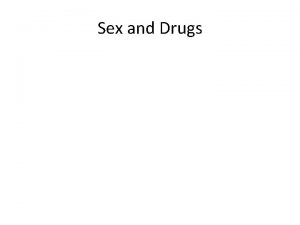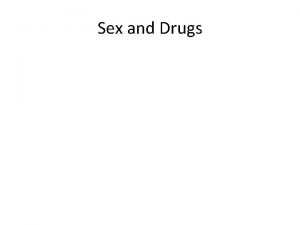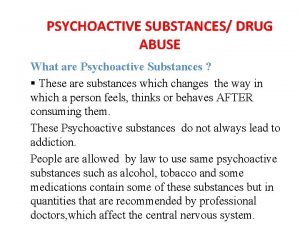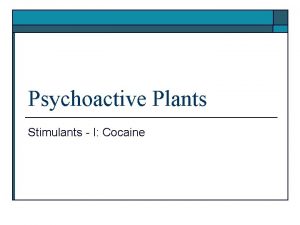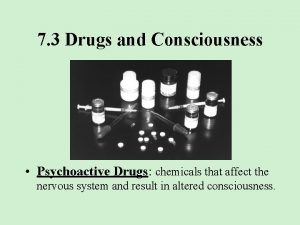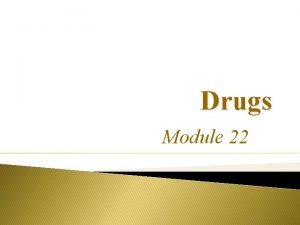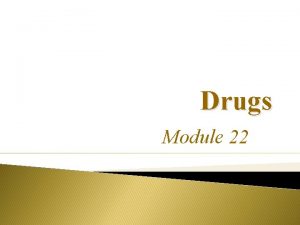LOVE SEX AND DRUGS SUMMARY Psychoactive drugs lower




























- Slides: 28

LOVE, SEX, AND DRUGS

SUMMARY Psychoactive drugs lower inhibitions and are used to enhance sexual activity. Initially, some drugs may increase sensation, but continued use can diminish sexual performance and pleasure. Lowered inhibitions sometimes lead to high risk sexual practices. Sexual violence, such as date rape, is strongly associated with drug use. Contaminated needles spread sexually transmitted diseases, such as HIV and AIDS, hepatitis, and gonorrhea.

MEDICATIONS AND ERECTILE DYSFUNCTION For centuries alcohol was the substance most associated with sexual activity. The advent of medications to treat erectile dysfunction has produced the most significant change in the use of drugs to enhance sexuality. Viagra in 1998, Cialis in 2003, and finally Levitra in 2005 are medications that enhance nitric oxide that eventually relaxes smooth muscles in the corpus cavernosum erectile tissue, allowing greater blood flow.

APHRODISIACS Medications like Viagra, Cialis, and Levitra are not true aphrodisiacs although they are used to enhance sexual activities. An aphrodisiac is defined as a drug or other agent that stimulates(enhances) sexual desire rather than something that augments sexual ability. Most drugs used to enhance sexual performance have no effect in the absence of sexual stimulation. � http: //youtu. be/KShkh. IXdf 1 Y

EFFECTS OF DRUGS The limited effect of erectile dysfunction drugs emphasizes the complexity of human sexuality. Our desire for friendship, affection, love, intimacy, and sex is a primary driving force in men and women, and drugs affect that primary force in many different and complicated ways. Some psychoactive drugs, such as alcohol, marijuana, and ecstasy lower inhibitions. Others, including cocaine, amphetamines, marijuana, and some inhalants are used to intensify and otherwise alter the physical sensations of sexuality and counter low self-esteem or shyness. Often psychoactive drugs substitute a simple physical sensation or the illusion of one, for more complex emotions, such as desire for intimacy and comfort, love of children, or release from anxiety. Many psychoactive drugs manipulate natural biochemicals, thereby stimulating, counterfeiting, blocking, or mixing up physical sensations and emotions.

IMPACT Drugs have an impact, both desired and undesired, on all phases of sexual behavior from puberty, through dating, to intimacy in marriage. Drinking a glass or two of wine to get in the mood, lighting up a cigarette after sex, using a popper to intensify an erection and orgasm, amphetamines to delay ejaculation, marijuana to enhance the newness of a situation, or ecstasy to increase empathy are evidence that drugs are desirable to a wide range of ages and cultures, particularly when shyness, lack of confidence, aging, or physical changes have diminished one’s desire and abilities.

IMPACT The same drugs, when used long term or in large doses, can also cause the reverse effects: � Lack of interest � Physical depression � Inability to achieve an erection or orgasm Certain drugs can also trigger sexual aggression, sexual harassment, rape (including date rape), and child molestation, particularly if one is already prone to such behavior. Drugs can also encourage high risk sexual behavior like multiple partners, anonymous sex, unprotected sex, and anal sex.

RISKY BUSINESS Prostitution to support one’s habit is another high risk behavior. Multiple partners, anonymous sex, unprotected sex, etc. can lead to the spreading of sexually transmitted diseases such as HIV and AIDS, syphilis, gonorrhea, and hepatitis B and C.

GENERAL EFFECTS Psychoactive drugs affect sexual desire, excitation, and orgasm. Physically, psychoactive drugs effect hormonal release(testosterone, estrogen, and adrenaline), blood flow, blood pressure, nerve sensitivity, and muscle tension that in turn effect excitation(erectile ability) and orgasm. Heroin desensitizes penal and vaginal nerve endings Alcohol diminishes spinal reflexes, decreasing sensitivity and erectile ability � Steroids increase testosterone making a user more sexually aggressive � Cocaine and amphetamines release dopamine, which stimulates the pleasure center in the limbic system, the same system is stimulated during excitation and orgasm � �

COMBINING SEX AND DRUGS Drugs affect sexuality by disrupting the neurotransmitters serotonin, dopamine, and norepinephrine. Serotonin affects mood, aggression, self-esteem Dopamine is believed to help regulate mood, emotional behavior, motor control, and orgasm, � Norepinephrine stimulates heart rate and body functions while increasing motivation and confidence � � Regular drug users often combine sex and drugs to lower their inhibitions, improve their performance, and increase their fantasies. Some people use drugs not only to enhance their sexuality but also to shield themselves from their sexuality or from emotional involvement. “As a teenager I was sort of shy, and the meth made me feel like I was supersmart, superpretty, a superperson. At that age I felt very awkward and uncomfortable without the drug. ” –Recovering meth user

ALCOHOL Alcohol’s physical affects on sexual functioning are closely related to blood alcohol levels. Its mental effects, however, have more to do with the user’s psychological makeup and the setting in which it is used. rather than the amount consumed.

ALCOHOL AND WOMEN Because alcohol diminishes sexual arousal, women can suffer low self-esteem and feelings of inadequacy. Even though many women report that alcohol use increases sexual pleasure, quantitative measures of physical sexual arousal and ability to have an orgasm decrease when blood alcohol levels increase. In one study of female chronic alcoholics, 36% said they had orgasms less than 5% of the time. The study also found that sexual dysfunction was the best predictor of continued problems with alcohol abuse. Heavy drinking produces increases in plasma testosterone, which can inhibit ovulation and decrease fertility. Heavy drinking also causes menstrual disturbances, spontaneous abortions, miscarriages, and fetal alcohol spectrum disorders. In both women and men, as drinking progresses, alcoholic

ALCOHOL AND MEN In men a blood alcohol concentration of 0. 05(about 3 beers in one hour for a 200 lb. male) has a very measurable physical effect on erectile ability. Physically, alcohol diminishes spinal reflexes, thus decreasing sensitivity and erectile ability. Even a few drinks lowers testosterone levels. A long term male drinker has decreased testosterone and an increase in female sex steroids, such as estradiol, and abnormalities in sex steroid metabolism. Initially, alcohol gives men more confidence because it acts on the area of the brain that regulates fight, fright, and fear, thereby promoting aggressiveness. As alcoholism progresses many men feel less sexual. A study reports impotence in 60% of heavy alcohol users.

COCAINE AND AMPHETAMINES Use initially increases confidence, prolongs an erection, increases endurance, and intensifies an orgasm during initial low-dose use. Cocaine and amphetamines increase the supply of dopamine and norepinephrine in the nervous system, inducing a rush of pleasure by affecting centers in the brain involved with sexual activity mostly in the limbic system. The difference in the two drugs is the duration of action. Methamphetamine lasts hours longer than cocaine and prolongs the stimulation.

COCAINE AND AMPHETAMINES Initial feelings can be so pleasurable to methamphetamines users that they begin to depend on the drug to enjoy sex. Continued use can then start the cycle of sexual dysfunction. Some users believe the crack cocaine enhances sexual pleasure, but in fact, particularly in women, it has been shown to induce a loss of sexual pleasure. Heavy or prolonged use of cocaine in men often causes a decrease in sexual desire, difficult achieving an erection, and delayed ejaculation. Pre-existing sexual proclivities are directly related to the effect and the effectiveness of drug use on sex. Someone who is usually shy or sexually inhibited will often get a boost of confidence from cocaine or methamphetamines. Someone who has unusual sexual practices will be more likely to intensify those behaviors under the influence of these drugs.

TOBACCO Physically, nicotine can both stimulate and relax, depending on the set(mood and mental state) and the setting(location). One survey found that adolescents who smoke are more likely to participate in risky behaviors, such a multiple partners, during their teen years, than those who don’t smoke. Long term tobacco use has been associated with lower testosterone levels and erectile dysfunction in men and reduced fertility in women, although not nearly to the degree caused by excessive cocaine of alcohol use.

OPIOIDS Downers are often used to lower inhibitions, though the physiological depressive effects often decrease performance and eventually desire. Long term heroin users reported impaired performance and a decrease in sexual drive. With continued use, some users became disinterested in sex and others wanted to repeat the experience of early use. The overall rate of impotence in one study of male addicts was 39%, jumping to 53% when the subjects were actually high. Reduced testosterone in men led to impotence in some, while long term female users reported menstrual irregularities, frigidity, and reduced fertility. This is due to inhibition of gonadotropin releasing hormone, a neurohormone that regulates the tests and ovaries.

SEDATIVE-HYPNOTICS Many sedatives, such as the benzodiazepines, barbiturates, and street Quaaludes, have been called “alcohol in pill form” and touted as sexual enhancers. They do lower inhibitions and make the user feel more relaxed, but they also induce physical depression that lowers the ability to perform or respond sexually. With abuse of sedative-hypnotics comes sexual dysfunction and total apathy toward sexual stimulation. Most of the short acting sedative-hypnotics also cause amnesia, such as Rohypnol. Sexual predators count on the fact that the victims they seduce and rape will have no memory of the event or the perpetrator.

ROHYPNOL Rohypnol(or Flunitrazepam) causes profound amnesia and lowered inhibitions as well as decreased ability to resist a sexual assault. It produces a half life of 16 to 35 hours, which enables it to accumulate in the system if taken on a regular basis. Though it is not as toxic as barbiturates, it can be dangerous when used with alcohol. Rohypnol is legal in some countries, but not in the United States. Due to an increase in knowledge and awareness of the drug it has been reformulated with a blue dye that releases when in contact with liquid, making it harder to slip into drinks.

GHB GHB, or gamma hydroxyburate, is a sedativehypnotic and a dopamine enhancer that was originally used as a sleep inducer, and paradoxically, to treat difficulty staying awake(narcolepsy). It has been popular on the club scene as a drug that will lower inhibitions and make sex more pleasurable. Doubling the dose that induces a pleasant effect can disrupt coordination, cause sleep, or induce coma within 10 to 20 minutes.

MARIJUANA Most of the reported effects from marijuana are anecdotal comments, such as feelings of sexual pleasure, rather than specifics like prolonged excitation or delayed orgasm. There are very few rigorous studies on marijuana and sexuality. Smoking marijuana to excess often prevents the user from learning how to have sexual relations without being high, so the cycle of use is perpetuated.

MDMA AND MDA, ORECSTASY Users say that unlike methamphetamines, ecstasy will calm them and give them warm feelings towards others, and induce a heightened sexual awareness. Although feelings of closeness and sensuality are enhanced, the ability to have an erection and an orgasm is compromised with higher doses of ecstasy. One of the effects of MDMA is the manipulation of serotonin. Possible dangers from excess use include high blood pressure, rapid heart rate, overheating, and prolonged disruption of serotonergic activity in the central nervous system.

MEPHEDRONE, PCP, AND LSD Mephedrone is also known as MCAT and meow. It is a synthetic variant of cathinone, the active ingredient in khat shrub. It produces similar effect to ecstasy, cocaine, or methamphetamines. It is marketed in the United States as a bath salt. PCP is not usually associated with sex, but because it is an anesthetic it has been used to deaden the pain of some unusual sex practices. LSD’s psychedelic like effects are so confusing to the senses that it is not considered a sexual enhancer.

SUBSTANCE ABUSE AND SEXUAL ASSAULT 1 in every 3 women in the United States will be a victim of sexual violence in her lifetime. In one study of sexual assaults, victims reported using drugs or alcohol in 51% of the cases; substance use by the assailants was found in 44% of the cases. In most cases the male user already had tendencies toward improper or aggressive behavior, and the alcohol or other drug served as a trigger Sexual abuse and domestic violence create the kind of trauma and emotional pain that can lead to the reckless use of drugs and alcohol.

SEXUALLY TRANSMITTED DISEASES Internationally the World Health Organization estimates that 340 million cases of STDs occur each year. � About 85% of all STDs occur in people between the ages of 15 and 30. � Almost half of all teenagers who are sexually active had chlamydia, the fastest spreading STD. � There were 42, 000 new cases of HIV infections in the United States in 2009.

NEEDLE-TRANSMITTED DISEASES Some of the most common diseases transmitted by needles are the various strains of hepatitis, viral infections of the liver. � � � Hepatitis B and C are associated most with IV drug use More than 75% of injection drug users test positive for hepatitis B. The blood-borne hepatitis C virus is more dangerous and can cause liver diseases, including cancer. The positive rate of hepatitis C users is 50% to 90%. Needle use can also cause abscesses at an infected injection site. Needle users are at risk for cotton fever and necrotizing fasciitis( flesh eating bacteria). Injection users are also at risk of developing endocarditis, a sometimes fatal condition caused by certain bacteria that lodge and grow in the valves of the heart.

HIV AND AIDS is fatal because HIV destroys the immune system, making it impossible for the body to fight off serious illnesses. Usually death occurs from a combination of many diseases and infections. IV use of a drug bypasses all of the body’s natural defenses, such as body hairs, mucous membranes, body acids, and enzymes; and once contracted, HIV destroys the body’s last line of defense. Worldwide there were an estimated 33. 3 million people living with HIV/AIDS in 2009. More than two-thirds live in sub. Saharan Africa and 2. 6 million are newly infected each year. However, the rate of infections is going down slowly. More than 1. 1 million Americans are infected with HIV or have AIDS.

PREVENTION OF DISEASE Continuing public education and public health prevention activities are crucial to stemming the spread of AIDS and every other sexually transmitted disease. Numerous strategies are in place to stop the spread of AIDS, particularly in the drug using community: Needle exchange programs to control transmission of the disease � Education and counseling programs � No cost antiviral drugs for HIV positive pregnant women and anyone else exposed to the virus � Easy access to condoms � Treatment on demand for drug addiction to encourage users to give up drugs Drug abuse treatment along with education and needleexchange programs that are tied to outreach components have proven to be the most effective IV disease prevention strategies. �
 Module 25 psychoactive drugs
Module 25 psychoactive drugs Seizure threshold meaning
Seizure threshold meaning Psychoactive drugs chart
Psychoactive drugs chart Kurt bumby
Kurt bumby Greenhouse sex
Greenhouse sex Xxtesticles
Xxtesticles Sex sex sex
Sex sex sex Sex sex sex
Sex sex sex Love love jesus is love god greatest gift lyrics
Love love jesus is love god greatest gift lyrics X linked dominant inheritance punnett square
X linked dominant inheritance punnett square Sex determination and sex linkage
Sex determination and sex linkage Sex determination and sex linkage
Sex determination and sex linkage That you must love me and love my dog summary
That you must love me and love my dog summary Once a sex offender always a sex offender
Once a sex offender always a sex offender The salvation of man is through love and in love
The salvation of man is through love and in love Passionate love vs companionate love
Passionate love vs companionate love Passionate love vs companionate love
Passionate love vs companionate love Infatuation meanin
Infatuation meanin Infatuation vs love
Infatuation vs love Infatuating
Infatuating Love is blind love is patient
Love is blind love is patient Companionate love vs consummate love
Companionate love vs consummate love Passionate love vs companionate love
Passionate love vs companionate love Love language test
Love language test Love for the sake of love
Love for the sake of love Nothing can separate even if i ran away
Nothing can separate even if i ran away Oh my.love my darling
Oh my.love my darling Courtly love tradition
Courtly love tradition Love is his way
Love is his way

